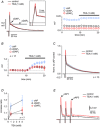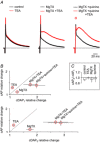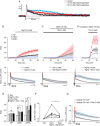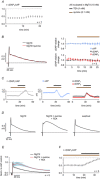Components of action potential repolarization in cerebellar parallel fibres
- PMID: 25239461
- PMCID: PMC4259535
- DOI: 10.1113/jphysiol.2014.280719
Components of action potential repolarization in cerebellar parallel fibres
Abstract
Repolarization of the presynaptic action potential is essential for transmitter release, excitability and energy expenditure. Little is known about repolarization in thin, unmyelinated axons forming en passant synapses, which represent the most common type of axons in the mammalian brain's grey matter.We used rat cerebellar parallel fibres, an example of typical grey matter axons, to investigate the effects of K(+) channel blockers on repolarization. We show that repolarization is composed of a fast tetraethylammonium (TEA)-sensitive component, determining the width and amplitude of the spike, and a slow margatoxin (MgTX)-sensitive depolarized after-potential (DAP). These two components could be recorded at the granule cell soma as antidromic action potentials and from the axons with a newly developed miniaturized grease-gap method. A considerable proportion of fast repolarization remained in the presence of TEA, MgTX, or both. This residual was abolished by the addition of quinine. The importance of proper control of fast repolarization was demonstrated by somatic recordings of antidromic action potentials. In these experiments, the relatively broad K(+) channel blocker 4-aminopyridine reduced the fast repolarization, resulting in bursts of action potentials forming on top of the DAP. We conclude that repolarization of the action potential in parallel fibres is supported by at least three groups of K(+) channels. Differences in their temporal profiles allow relatively independent control of the spike and the DAP, whereas overlap of their temporal profiles provides robust control of axonal bursting properties.
Figures







Similar articles
-
Typical gray matter axons in mammalian brain fail to conduct action potentials faithfully at fever-like temperatures.Physiol Rep. 2016 Oct;4(19):e12981. doi: 10.14814/phy2.12981. Physiol Rep. 2016. PMID: 27707780 Free PMC article.
-
Action potentials recorded from bundles of very thin, gray matter axons in rat cerebellar slices using a grease-gap method.J Neurosci Methods. 2012 Jul 15;208(2):119-27. doi: 10.1016/j.jneumeth.2012.05.005. Epub 2012 May 11. J Neurosci Methods. 2012. PMID: 22579878
-
Kv7/KCNQ/M-channels in rat glutamatergic hippocampal axons and their role in regulation of excitability and transmitter release.J Physiol. 2006 Oct 1;576(Pt 1):235-56. doi: 10.1113/jphysiol.2006.111336. Epub 2006 Jul 13. J Physiol. 2006. PMID: 16840518 Free PMC article.
-
Bursts and hyperexcitability in non-myelinated axons of the rat hippocampus.Neuroscience. 2010 Jun 2;167(4):1004-13. doi: 10.1016/j.neuroscience.2010.03.021. Epub 2010 Mar 16. Neuroscience. 2010. PMID: 20302917
-
Action potential repolarization and a fast after-hyperpolarization in rat hippocampal pyramidal cells.J Physiol. 1987 Apr;385:733-59. doi: 10.1113/jphysiol.1987.sp016517. J Physiol. 1987. PMID: 2443676 Free PMC article. Review.
Cited by
-
Typical gray matter axons in mammalian brain fail to conduct action potentials faithfully at fever-like temperatures.Physiol Rep. 2016 Oct;4(19):e12981. doi: 10.14814/phy2.12981. Physiol Rep. 2016. PMID: 27707780 Free PMC article.
-
The Slow Depolarization Following Individual Spikes in Thin, Unmyelinated Axons in Mammalian Cortex.Front Cell Neurosci. 2019 May 16;13:203. doi: 10.3389/fncel.2019.00203. eCollection 2019. Front Cell Neurosci. 2019. PMID: 31156391 Free PMC article.
References
-
- Blanton MG, Lo Turco JJ, Kriegstein AR. Whole cell recording from neurons in slices of reptilian and mammalian cerebral cortex. J Neurosci Methods. 1989;30:203–210. &. - PubMed
-
- Braitenberg V, Schüz A. Cortex: Statistics and Geometry of Neuronal Connectivity. Berlin: Springer; 1998. , &.
Publication types
MeSH terms
Substances
Grants and funding
LinkOut - more resources
Full Text Sources
Other Literature Sources
Research Materials
Miscellaneous

